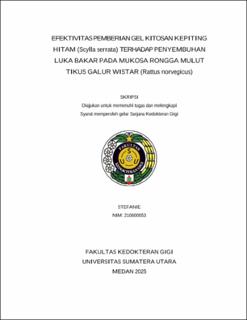Efektivitas Pemberian Gel Kitosan Kepiting Hitam (Scylla serrata) terhadap Penyembuhan Luka Bakar pada Mukosa Rongga Mulut Tikus Galur Wistar (Rattus norvegicus)
Effectiveness of Giant Mud Crab (Scylla serrata) Chitosan Gel in Healing Oral Mucosal Burn Wound in Wistar Rats (Rattus norvegicus)

Date
2025Author
Stefanie, Stefanie
Advisor(s)
Rusdy, Hendry
Agusnar, Harry
Metadata
Show full item recordAbstract
Wounds are defined as the loss or damage of epithelial tissue. One such type of wound is burn wound. In dentistry, burns can occur due to iatrogenic errors, drug application, or the use of dental materials. Burns in the oral cavity can interfere with daily functions, and the unusual conditions in the oral cavity may delay the wound healing process. Thus, there is a need for wound healing agents that can help in the process. Chitosan, a natural biopolymer derived from chitin, is widely used in healthcare due to its various beneficial properties. The shell of the giant mud crab (Scylla serrata) contains higher chitin content compared to other animals, making it an ideal source for chitosan. This study aims to assess the effectiveness of giant mud crab chitosan gel in promoting the healing of burn wounds on the oral mucosa of Wistar rats. The type of the study is laboratory experimental research with a post-test only control design. The research samples consisted of Wistar rats which were divided into seven groups: Aloclair Plus gel as the positive control; chitosan gels at concentrations of 0.5%, 1%, 1.5%, 2%, and 2.5%; and HPMC gel as negative control. The research was carried out by observing erythema, edema, and wound closure on days 1, 3, and 7. The results of the Kruskal-Wallis and One Way ANOVA tests showed that the 1%, 1.5%, 2%, and 2.5% chitosan gels were effective in promoting burn wound healing on the oral mucosa of Wistar rats, with the 2.5% chitosan gel being the most effective gel concentration.
Collections
- Undergraduate Theses [1908]
